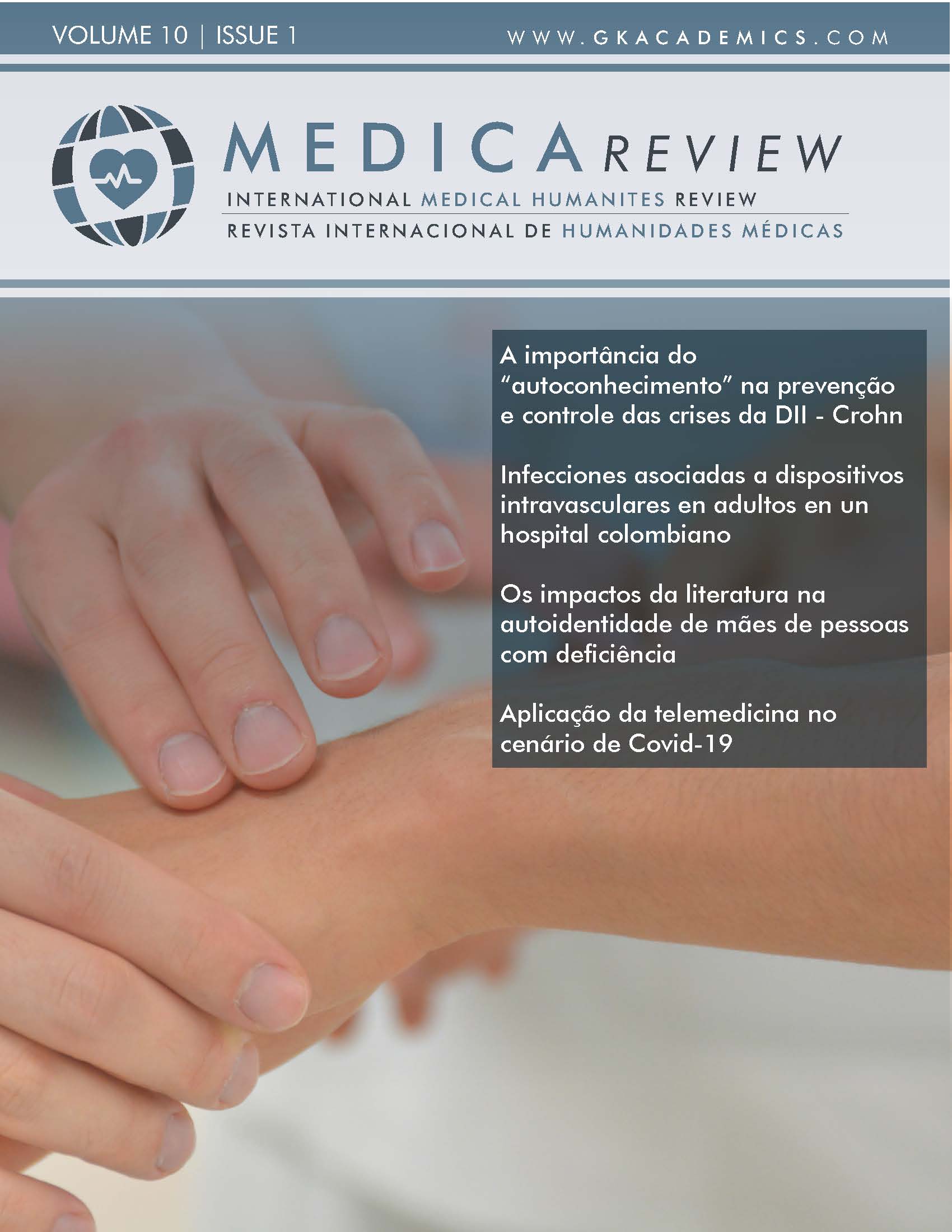Infections Associated with Intravascular Devices in Adult Patients in a Colombian Hospital
DOI:
https://doi.org/10.37467/gkarevmedica.v10.3212Keywords:
Central venous Access, Intravascular device, Peripheral vascular line, Infection, Bacteremia, PrevalenceAbstract
Objective: to describe the prevalence of infections associated with devices over a period of 48 months. Material and method: observational cross-sectional study with patients older than 18 years with bacteraemia associated with a device at the San Rafael Clinical University Hospital in Bogotá, Colombia. Results: prevalence of 1.59%, 14.29% were complicated, finding that 60% were endocarditis and 40% were septic thrombosis. Gram-negative bacilli contributed 63.04% mostly Klebsiella pneumonaie. Discussion: prevalence of infections associated with intravascular devices is lower than previously reports.
References
Aggoune, M., Aho, L., Amazian, K., Astagneau, P., & Atif. (2019). Prévention des infections liées aux cathéters périphériques vasculaires et sous-cutanés. Hygienes. https://bit.ly/3P1Kukj
Almirante, B., Limón, E., Freixas, N., & Gudiol, F. (2012). Laboratory-based surveillance of hospital-acquired catheter-related bloodstream infections in Catalonia. Results of the VINCat Program (2007–2010). Enfermedades Infecciosas y Microbiología Clínica, 30, 13-19. https://doi.org/10.1016/S0213-005X(12)70091-5 DOI: https://doi.org/10.1016/S0213-005X(12)70091-5
Asamblea Mundial de la Salud, 72. (2019). Report on the Burden of Endemic Health Care-Associated Infection Worldwide A systematic review of the literature. Organización Mundial de la Salud. https://apps.who.int/iris/handle/10665/328697
Cantón-Bulnes, M. L., & Garnacho-Montero, J. (2019). Practical approach to the management of catheter-related bloodstream infection. Revista espanola de quimioterapia: publicacion oficial de la Sociedad Espanola de Quimioterapia, 32 Suppl 2(Suppl 2), 38–41.
Casimero, C., Ruddock, T., Hegarty, C., Barber, R., Devine, A., & Davis, J. (2020). Minimising Blood Stream Infection: Developing New Materials for Intravascular Catheters. Medicines, 7(9), 49. https://doi.org/10.3390/medicines7090049 DOI: https://doi.org/10.3390/medicines7090049
Chapon, V. (2019). Bactériémies liées aux cathéters veineux centraux: Épidémiologie, microbiologie, complications et prise en charge thérapeutique. Médecine humaine et pathologie. Université de Bordeaux. https://dumas.ccsd.cnrs.fr/dumas-02493501
Cuezva Arin, I. (2019). Prevención de la bacteriemia relacionada con catéter venoso central en las unidades de cuidados intensivos. Revisión Bibliográfica [Trabajo de fin de grado]. Universidad de Valladolid.
Ediap, L., Córdova, S., Zúñiga, E., Usedo, P., Muñoz, A., Fernández, G., Reales, F. y Gladic, M. (2017). Endocarditis infecciosa asociada a catéter de hemodiálisis: Hallazgos clínicos y ecocardiográficos. Revista chilena de cardiología, 36(3), 221-231. https://doi.org/10.4067/S0718-85602017000300221 DOI: https://doi.org/10.4067/S0718-85602017000300221
Erbay, A., Ergönül, Ö., Stoddard, G. J., & Samore, M. H. (2006). Recurrent catheter-related bloodstream infections: Risk factors and outcome. International Journal of Infectious Diseases, 10(5), 396-400. https://doi.org/10.1016/j.ijid.2005.08.002 DOI: https://doi.org/10.1016/j.ijid.2005.08.002
Ferrer, C. y Almirante, B. (2014). Infecciones relacionadas con el uso de los catéteres vasculares. Enfermedades Infecciosas y Microbiología Clínica, 32(2), 115-124. https://doi.org/10.1016/j.eimc.2013.12.002 DOI: https://doi.org/10.1016/j.eimc.2013.12.002
Fortún, J. (2008). Infecciones asociadas a dispositivos intravasculares utilizados para la terapia de infusión. Enfermedades Infecciosas y Microbiología Clínica, 26(3), 168-174. https://doi.org/10.1157/13116754 DOI: https://doi.org/10.1157/13116754
Gómez, J., Pimienta, L., Pino, R. F., Hurtado, M., & Villaveces, M. (2017). Prevalencia de infección asociada a catéter de hemodiálisis en el Hospital Universitario Clínica San Rafael. Revista Colombiana de Nefrología, 5(1), 17-25. https://doi.org/10.22265/acnef.5.2.283 DOI: https://doi.org/10.22265/acnef.5.2.283
Gorocito, M., Carreau, H., Vallejos, R., Fernández, A., Struminger, M. y Prieto, N. (2003). Endocarditis por infección de catéter marcapasos definitivo. Rev. Argent. Cardiol, 71(2), 122-125. https://pesquisa.bvsalud.org/portal/resource/pt/lil-388553
Grothe, C., Belasco, A. G. da S., Bittencourt, A. R. de C., Vianna, L. A. C., Sesso, R. de C. C., & Barbosa, D. A. (2010). Incidence of bloodstream infection among patients on hemodialysis by central venous catheter. Revista Latino-Americana de Enfermagem, 18(1), 73-80. https://doi.org/10.1590/S0104-11692010000100012 DOI: https://doi.org/10.1590/S0104-11692010000100012
Instituto Nacional de Salud. (2012). INFORME FINAL INFECCIONES ASOCIADAS A DISPOSITIVOS, COLOMBIA 2013. INS. https://bit.ly/3AnYh0v
Klevens, R. M., Edwards, J. R., Richards, C. L., Horan, T. C., Gaynes, R. P., Pollock, D. A., & Cardo, D. M. (2007). Estimating Health Care-Associated Infections and Deaths in U.S. Hospitals, 2002. Public Health Reports, 122(2), 160-166. https://doi.org/10.1177/003335490712200205 DOI: https://doi.org/10.1177/003335490712200205
Lopez-Cortes, L. E., del Toro, M. D., Galvez-Acebal, J., Bereciartua-Bastarrica, E., Farinas, M. C., Sanz-Franco, M., Natera, C., Corzo, J. E., Lomas, J. M., Pasquau, J., del Arco, A., Martinez, M. P., Romero, A., Muniain, M. A., de Cueto, M., Pascual, A., Rodriguez-Bano, J., for the REIPI/SAB group, Velasco, C., … Manzano-Gamero, V. (2013). Impact of an Evidence-Based Bundle Intervention in the Quality-of-Care Management and Outcome of Staphylococcus aureus Bacteremia. Clinical Infectious Diseases, 57(9), 1225-1233. https://doi.org/10.1093/cid/cit499 DOI: https://doi.org/10.1093/cid/cit499
Maki, D. G., Kluger, D. M., & Crnich, C. J. (2006). The Risk of Bloodstream Infection in Adults With Different Intravascular Devices: A Systematic Review of 200 Published Prospective Studies. Mayo Clinic Proceedings, 81(9), 1159-1171. https://doi.org/10.4065/81.9.1159 DOI: https://doi.org/10.4065/81.9.1159
Mermel, L. A., Allon, M., Bouza, E., Craven, D. E., Flynn, P., O’Grady, N. P., Raad, I. I., Rijnders, B. J. A., Sherertz, R. J., & Warren, D. K. (2009). Clinical Practice Guidelines for the Diagnosis and Management of Intravascular Catheter-Related Infection: 2009 Update by the Infectious Diseases Society of America. Clinical Infectious Diseases, 49(1), 1-45. https://doi.org/10.1086/599376 DOI: https://doi.org/10.1086/599376
Olaechea, P., Palomar, M., Ávarez, F., Otal, J., Insausti, J., & López, J. (2013). Morbidity and mortality associated with primary and catheter-related bloodstream infections in critically ill patients. Rev Esp Quimioter, 26(1), 21-29.
Organización Mundial de la Salud. (2010). Una atención limpia es una atención más segura 10 000 de aquí al 2010 – una llamada a la acción. OMS. https://www.who.int/gpsc/5may/resources/10000_2010_llamada_accion.pdf
Organización Panamericana de la Salud. (2012). Vigilancia epidemiológica de las infecciones asociadas a la atención de la salud. OPS. https://bit.ly/3u1IeRF
Osorio, J., Álvarez, D., Pacheco, R., Gómez, C. A. y Lozano, A. (2013). Implementación de un manojo de medidas (bundle) de inserción para prevenir la infección del torrente sanguíneo asociada a dispositivo intravascular central en Cuidado Intensivo en Colombia. Revista chilena de infectología, 30(5), 465-473. https://doi.org/10.4067/S0716-10182013000500001 DOI: https://doi.org/10.4067/S0716-10182013000500001
Rodrigo Rivas, T. (2011). Complicaciones mecánicas de los accesos venosos centrales. Revista Médica Clínica Las Condes, 22(3), 350-360. https://doi.org/10.1016/S0716-8640(11)70435-7 DOI: https://doi.org/10.1016/S0716-8640(11)70435-7
Rosenthal, V. D. (2006). Device-Associated Nosocomial Infections in 55 Intensive Care Units of 8 Developing Countries. Annals of Internal Medicine, 145(8), 582-591. https://doi.org/10.7326/0003-4819-145-8-200610170-00007 DOI: https://doi.org/10.7326/0003-4819-145-8-200610170-00007
Sabatier, C., Peredo, R., & Vallés, J. (2009). Bacteriemia en el paciente crítico. Medicina Intensiva, 33(7), 336-345. https://doi.org/10.1016/j.medin.2008.08.001 DOI: https://doi.org/10.1016/j.medin.2008.08.001
Safdar, N., Kluger, D. M., & Maki, D. G. (2002). A Review of Risk Factors for Catheter-Related Bloodstream Infection Caused by Percutaneously Inserted, Noncuffed Central Venous Catheters: Implications for Preventive Strategies. Medicine, 81(6), 466-479. https://doi.org/10.1097/00005792-200211000-00007 DOI: https://doi.org/10.1097/00005792-200211000-00007
Safdar, N., & Maki, D. G. (2002). Inflammation at the insertion site is not predictive of catheter-related bloodstream infection with short-term, noncuffed central venous catheters. Crit Care Med, 30(12), 2632–2635. https://doi.org/10.1097/00003246-200212000-00003 DOI: https://doi.org/10.1097/00003246-200212000-00003
Sandoval, M., Guevara, A., Torres, K. y Viloria, V. (2013). Epidemiología de las infecciones intrahospitalarias por el uso de catéteres venosos centrales. Kasmera, 41(1), 7-15.
Sawyer, M., Weeks, K., Goeschel, C. A., Thompson, D. A., Berenholtz, S. M., Marsteller, J. A., Lubomski, L. H., Cosgrove, S. E., Winters, B. D., Murphy, D. J., Bauer, L. C., Duval-Arnould, J., Pham, J. C., Colantuoni, E., & Pronovost, P. J. (2010). Using evidence, rigorous measurement, and collaboration to eliminate central catheter-associated bloodstream infections: Critical Care Medicine, 38, S292-S298. https://doi.org/10.1097/CCM.0b013e3181e6a165 DOI: https://doi.org/10.1097/CCM.0b013e3181e6a165
Vergara, T., y Tica, A. (2015). Estudio de costo de las infecciones del torrente sanguíneo asociadas a catéter vascular central en pacientes adultos en Chile. Revista chilena de infectología, 32(6), 634-638. https://doi.org/10.4067/S0716-10182015000700004 DOI: https://doi.org/10.4067/S0716-10182015000700004
Villalobos, A. P., Barrero, L. I., Rivera, S. M., Ovalle, M. V. y Valera, D. (2013). Vigilancia de infecciones asociadas a la atención en salud, resistencia bacteriana y consumo de antibióticos en hospitales de alta complejidad, Colombia, 2011. Biomédica, 34(0), 67-80. https://doi.org/10.7705/biomedica.v34i0.1698 DOI: https://doi.org/10.7705/biomedica.v34i0.1698
Downloads
Published
How to Cite
Issue
Section
License
Those authors who publish in this journal accept the following terms:
- Authors will keep the moral right of the work and they will transfer the commercial rights.
- After 1 year from publication, the work shall thereafter be open access online on our website, but will retain copyright.
- In the event that the authors wish to assign an Creative Commons (CC) license, they may request it by writing to publishing@eagora.org









